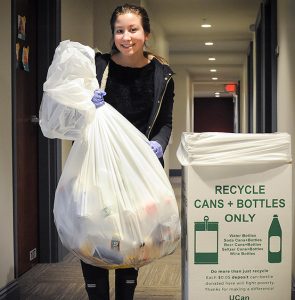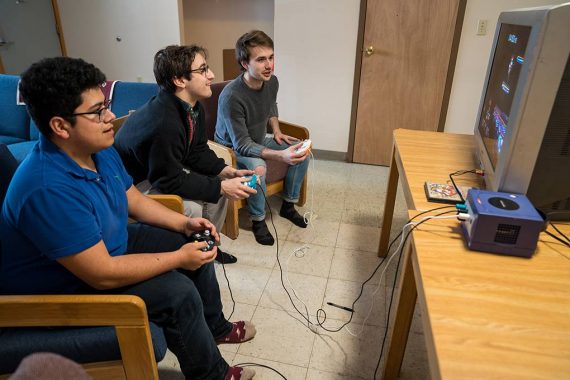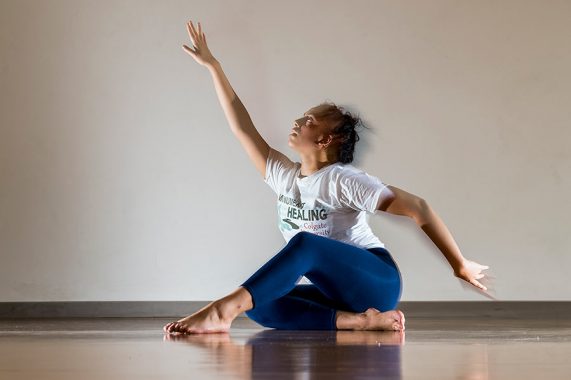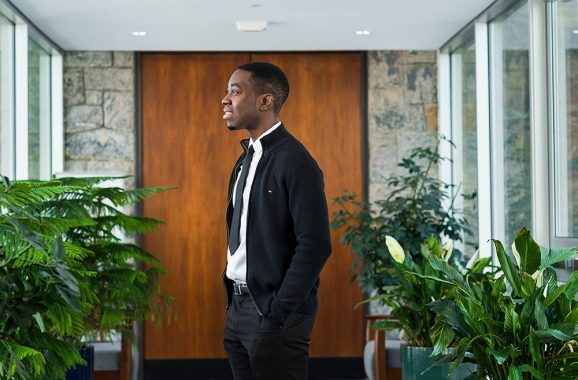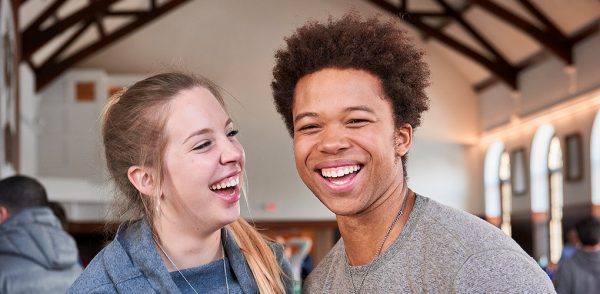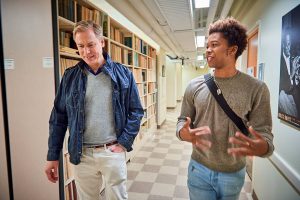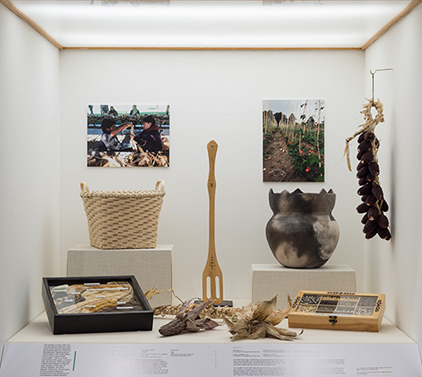Enhancing the Senior Torchlight Procession
President Brian W. Casey has announced a series of enhancements to the Senior Torchlight Procession, which will be implemented during this year’s commencement weekend. Casey made the announcement in mid-April.
First, in place of wood torches, the university will provide each graduating senior with one made of brass, which was designed based on the university’s seal and will represent the Torch of Knowledge.
“Through the use of this new torch, we will directly root the ceremony in Colgate’s history,” Casey wrote in an e-mail to the campus community. The Torchlight Working Group forwarded this message with details to alumni.
In forthcoming years, students will return the torches at the end of the ceremony in order to avoid the need to replicate them each year. But for this year, a former Alumni Council member has provided funds to allow the Class of 2018 to keep their torches.
Music will be added to the ceremony, both as the class gathers in the Academic Quad and as the procession moves down the hill. “This will, I believe, add considerably to the grandeur of the procession,” Casey wrote.
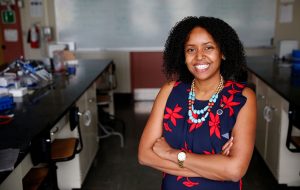
Back on campus: Read about how Krystle McLaughlin ’06 uses crystals to combat bacterial infections. Photo by Stephanie Veto
Further, as many students requested, the procession route will be modified so that the class will walk through Willow Path — which will be lit with white lights.
Finally, the procession will conclude with a president’s reception. Food and champagne, music and a dance floor will be available in a large tent that can comfortably accommodate all students and their families as well as faculty members and friends.
These enhancements to the ceremony are in response to several years of discussions in the Colgate community about the form and nature of the Senior Torchlight Procession. National events, specifically the riot in Charlottesville, Va., created a sense of urgency for change.
So, Casey spent months meeting with a variety of student organizations, including the Black Student Union, Hillel and other religious groups, and Konosioni. These conversations were informed by the work of Barnaby Evans, an artist-in-residence whom Casey brought on board to facilitate campuswide discussions.
From these conversations, the president said, he learned several things, including the importance of ceremony and a hunger for more rituals at Colgate; a lack of understanding among the student body about the meaning and history of the Senior Torchlight Procession; and a desire for improvements to a ceremony that has, over the years, become poorly organized, confusing, and inelegant.
The Senior Class Torchlight Working Group, organized by Class President Madison Bailey ’18, and the Alumni Council Torchlight Working Group collaborated with Casey to consider how best to enhance and improve the ceremony.
He discussed proposed event changes with two faculty governance committees, the Advisory and Planning Committee and the Student Advisory Board. Initial ideas for changes to the ceremony were also presented earlier this semester at a Maroon-News forum.
“Ceremonies, ideally, remind us of our highest ideals,” Casey wrote. “They connect participants one to another, and to those who have gone before us. . . I believe the enhancements and changes will move us toward a stronger expression of our highest values during commencement weekend.”
Traditions always evolve, he further noted. “With these changes, we will have gone a long way toward significantly enhancing an important occasion for graduates and their families, one rooted in Colgate’s history, but also one that looks forward to the university’s third century.”
She can
Christina Weiler ’21 believes in the value of waste. The truth about waste, she says, is that it is a part of us, and we are responsible for it. In order to put plastic in a place where it belongs, Weiler came up with the UCan project, a beverage container recycling initiative that gives its proceeds to local hunger and homeless outreach programs.
“UCan’s goal is not just about helping the environment, but also about bringing awareness to different social causes,” says Weiler, who launched the program last fall through Colgate’s Thought Into Action (TIA) entrepreneurship program. Weiler has been further developing the initiative this year with the help of Cornell alumna Eleanore Baughan.
Weiler and her team set up 40 receptacles that are available in more than 13 academic and residential buildings and two fraternities. After gathering bottles and cans from each receptacle, she takes them to the local redemption center, which reimburses the team $0.05 per container. All the money raised from UCan’s bottles and cans is then donated to local homeless outreach programs, including the rescue mission and an affordable housing project in Utica.
She calculated that during Colgate’s 30-week academic year, its 2,700 students use approximately 648,000 cans and bottles, which is a $32,400 opportunity. If she meets this goal, Weiler hopes to distribute her proceeds to organizations that help people on a national scale, such as Feeding America.
TIA helped Weiler develop UCan through accounting workshops, team building, and creating proposals. With TIA seed grants, Weiler bought receptacles and hired a building and grounds officer to drive a truck to the redemption center.
After advertising UCan at Colgate’s Student Activities Fair, 59 students signed up. With the help from peers, she believes her initiative can expand to other college campuses. “We hope to reach as many students as possible, increase recycling rates on college campuses, and encourage students to make a difference within their communities,” Weiler says.
— Veronica Chen ’20
Game on
In Cushman House’s living room, gamers are squeezed together on couches amid TVs, a cluster of controllers, chargers, and discarded shoes. As the week’s Smash Club tournament is about to start, students snack on Kool-Aid and a member’s home-baked cookies while they unabashedly fight over who plays as Princess Zelda — evidently, a highly sought-after character in the video game Super Smash Bros.
The Smash Club student group has come a long way since Jonathan Morales ’18 and Marc Maggiore ’18 discovered their mutual interest during their first year. In crowded dorm rooms, the two would spend hundreds of hours playing Smash — competing as various Nintendo characters keenly fighting to knock out Kirby, pull off ledge recoveries, or final smash Bowser off a perpetually moving spaceship stage. The rivalries between the players as well as the precarious balance between sociable fun and intense competition defined these gatherings.
Maggiore and Morales decided to start an official Smash Club because they wanted to create a space for true competition in the game.
“We had a group of guys, probably sixteen, who regularly played, and it started growing,” Maggiore says.
Over the past three years, Morales and Maggiore have created, developed, and grown the student organization, which hosts biweekly tournaments for players to compete in both Super Smash Bros Melee and Super Smash Bros for the Wii U. With more than 70 active members, events featuring guest speakers, and larger tournaments with other schools, including Cornell, the Smash Club has leveled up in a major way.
Smash is classified as an esport, which entails professional players, teams, coaches, tournaments, and lucrative careers for top players due to merchandise deals, advertising on websites and livestreaming platforms, sponsorships, and prize money. With more than $50,000 up for grabs at major tournaments, wins are important, and players are serious about trying to catch ’em all.
This virtual pastime is making a very real impact on campus. Last fall, the club brought Juan DeBiedma (known by his tag Liquid | “hungrybox”), who was the number one Smash player in the world, to Colgate for four days. Another of the club’s greatest successes happened recently when a play by Jacob Pilawa ’20 attracted more than 15,000 views on EvenMatchupGaming, the largest channel featuring weekly highlights.
Moving forward, the club hopes to bring in more speakers and acquire funding for top players to compete in a national collegiate Smash tournament.
“It’s really special to create this club from eight people who played in a dorm room,” Morales says. “It means our work has paid off.”
— Lauren Hutton ’21
Healing with Haven
When Jailekha Zutshi ’21 walked through the streets in her hometown of Delhi, India, she felt unsafe. Even in broad daylight with people all around, Zutshi says, she constantly felt men’s eyes on her. So, she always kept her phone in hand and her mother on speed dial.
“Delhi has a very high rate of sexual violence,” Zutshi explains. (In fact, it is one of the top two worst cities in the world for sexual violence against women, according to Reuters.) There is no ongoing conversation about sexual violence in India, she says. “Every time an assault or a case of rape happens, we’ll talk about it then, and [the topic will] just die down.”
Though her generation is more open to talking about sexual assault and violence, Zutshi says, India has a long way to go. Because she felt unsafe participating in the conversation there, she decided to do so here at Colgate.
As an intern at Haven, the university’s sexual violence response center, Zutshi is addressing the topic of sexual violence through an initiative that draws upon her childhood passion: dance.
“For me, dancing is enjoyable but can also be therapeutic,” she says. “It’s very expressive.”
Zutshi’s project is called “Meraki,” a Greek word used to describe acting with passion, creativity, and soul. She chose the name because it can also mean putting a bit of yourself into what you’re doing.
“It’s a workshop for survivors and other students who want to reflect and heal. It’s a chance to come together to improvise and create their own choreography,” she says. “The movements narrate the story they choose to share, thereby leaving a piece of themselves in their work.”
The sessions consist of three parts: basic warm-ups, improvisations, and a participant-chosen activity. Students warm up with stretches that loosen up joints and key muscle groups. With the improvisation section, they dance to one piece of music, following their own rhythms. For the last activity, dancers can choose either to improvise to different songs individually or in a group or to have a discussion about how the dancing made them feel. Zutshi plays varying types of music, from upbeat tunes to slower, mellow songs. For now, none of the songs include lyrics, but she’s considering adding music with words in future sessions.
“There’s an overwhelming number of songs about romance, and I didn’t want that to influence their movements in any way,” Zutshi says. “The goal is, if they want to disconnect from their lives at Colgate, or even outside of that, for any period of time, they should be able to do so.”
Anna Brown ’21, who attended a workshop in January, notes, at the beginning of the sessions, it took some time for people to become comfortable. But once participants started dancing, the room relaxed.
“People really got into it,” she says. Like Zutshi, she feels the sessions are fun, but they’re also reverent.
Meraki allows the dancers to express feelings through motions, not words, Zutshi says, and the vibe at each session is deeply personal.
“I think Meraki allows people to be comfortable being by themselves and experiencing their own stories, even while being in the midst of everyone else,” she says.
“It’s just you, your breath, your body, and the music. That’s it.”
— Rebecca Docter
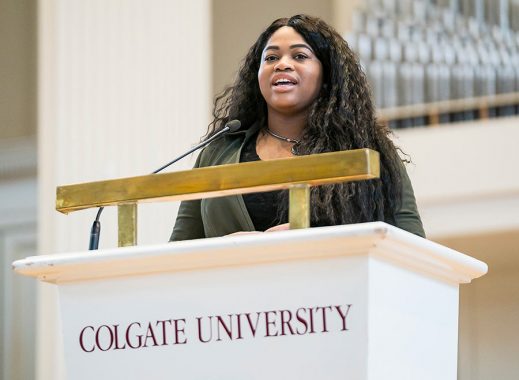
“What are you doing to make a difference in this world? What are you doing to live out Dr. King’s dreams?” Chinyere Okogeri ’18 (pictured) posed these questions to the audience during her keynote speech at the opening ceremony for Colgate’s Martin Luther King Jr. Week. The week of events also included a keynote by Loretta Ross, cofounder of the SisterSong Women of Color Reproductive Justice Collective; workshops and discussions led by professors and staff members; and a day of service when students volunteered at local organizations. Photo by Mark DiOrio
Heeding the call
An air of peacefulness and tranquility radiates from Rodney Agnant ’14.
Of course, his work environment is a contributing factor. Agnant is resident program coordinator of Chapel House, the campus spiritual retreat center that welcomes guests of any or no religious affiliation. Residing in the living quarters, his commute involves walking down the hall. And the dress code calls for slippers (everyone removes their shoes walking in the door).
Agnant, who has spent much of his young life digging deep and exploring his inner self, is a natural fit in this atmosphere that is considered one of the most hallowed spaces on campus.
Raised Catholic, Agnant came to Colgate wanting to enhance his spirituality. “When I got to college, I thought, going to church every week is nice and good, but I also needed to understand what this faith really means and have a more personal connection to it,” he says.
While majoring in French and minoring in psychology, Agnant joined the Colgate Christian Fellowship, Newman Community, and Interfaith Community. He discovered a new perspective sophomore year at a lecture by Eboo Patel about the importance of interreligious dialogue and building interreligious community. “That lens opened up,” Agnant says. “I realized I can honor my own faith but also get to know so much more about other faiths.”
After graduation, Agnant returned to his hometown of New York City to work for several consulting companies and organizations. His various roles shared a common thread of helping build companies’ cultures and systems — skills that perfectly prepared him for what he’s now doing at his alma mater.
Even in the bustling Brooklyn environs — often on the subway, of all places — Agnant was able to tap into his introspection. “There is something beautiful about being on the train and knowing there are a few hundred other people on this train. And because of that, it became a place of solitude and reflection for me,” he says. Agnant would read the Bible, write in his journal, meditate, or a combination of the three during his commute.
In 2016, he received a text from an old friend who was a Colgate senior at the time. Then texts from other Colgate students started lighting up his phone. He learned that they’d gathered for a Newman Community lunch, during which Catholic Campus Minister Mark Shiner asked the group to name a spiritual role model. One name kept coming up: Rodney. Shiner, who happened to be on the search committee for the new Chapel House position, called Agnant and asked him to apply.
Agnant was the ideal candidate, having spent his student years building relationships across campus. “The isolation Colgate provides creates a good opportunity for people to connect more — and that drew me in to wanting to meet people and hear their stories.”
As a staff member, he continues to create connections. “Rodney is an open, honest, and cheerful person whom people gravitate toward as a trustworthy human presence,” says Chapel House Director Steven Kepnes.
Agnant’s role is three-pronged: assisting the director, ensuring Chapel House is in tip-top shape for use, including overnight stays, and coordinating outreach programs — “so students can see how to integrate into their lives the contemplation that comes with Chapel House,” Agnant says.
One of the most popular events he has conceived is a “Design Your Own Life” retreat where students “think about what it means to have a vision for your life, be in touch with their creative process around that, and afterward think about what it means to take ownership over that vision,” he explains. “The idea isn’t that a student will walk away with a hundred-year plan and follow it to a T. But, rather, the sense of creation and intention is something they will revisit throughout their lives.”
Outside of his official role, Agnant is actively involved on campus. He opened this year’s Gospel Fest with an inspirational rendition of “We Shall Overcome.” Also this semester he gave a Heretics Club talk on authenticity of self. “I share this idea that everything you do is real; there is always a real reason why you do it,” he says. “I think one of the greater questions we can ask is about integrity — what are the deepest promises you have to yourself, the things that bring you the most meaning, and how can you find a way to honor those?”
His ultimate message to students is the one Agnant internalized when he was in their shoes: “Understand the power people have within; a sense of identity can transform your experience at Colgate and afterward,” he says. “It’s important to not only spend time with the studies of our academics, but also the studies of ourselves.”
— Aleta Mayne
The art of entrepreneurship
For Brandon Doby ’18 and Lauren Sanderson ’18, entrepreneurship exists at the intersection of business acumen and creative risk. The two seniors are both artists and business owners: They created ISO Film as a Thought Into Action (TIA) venture in 2016 and have been making experimental films ever since.
“To sustain yourself as an artist, you need to master the business side too,” said Doby, a studio arts major from Chicago.
Their venture took center stage during Colgate’s annual Entrepreneur Weekend on April 7 when TIA students presented their projects. The day was packed with pitching and networking, and it contained a few surprises for the pair.
Sanderson and Doby had an impromptu breakfast meeting with Jeffrey Sharp ’89 (pictured right), a successful filmmaker known for Boys Don’t Cry and Proof. The pair gave Sharp a tour of the audio and video studios they use on the first floor of Case-Geyer Library.
11:30 a.m.
Doby and Sanderson put the finishing touches on their booth alongside other student entrepreneurs in the Hall of Presidents. The pair had clips of their projects — including music videos and experimental shorts — rolling on a TV screen and copies of screenplays on the table.
ISO Film has two branches: ISO Works, for commissioned projects like event coverage and music videos, and ISO Labs, through which the pair has directed several short films and recently finished a documentary.
1:30 p.m.
The main event was the Shark Tank–style competition, for which Sharp was one of the panelists. Doby and Sanderson delivered their pitch to the panel of four “sharks” under a strict time limit — an ominous gong sound effect rang through the Hall of Presidents when their two minutes were up.
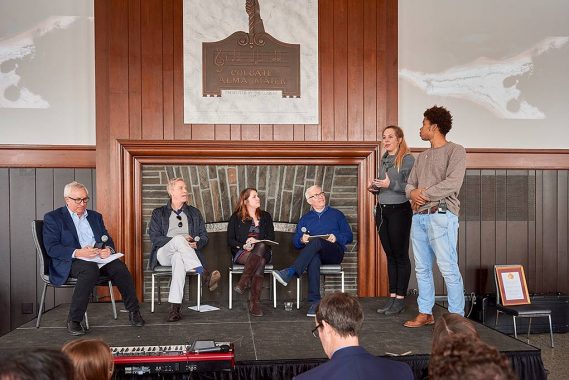
2:00 p.m.
After the panelists deliberated, they awarded $1,000 to ISO, and Sharp announced he would commission ISO Film to work on a small project for his production company.
Doby and Sanderson also won a $13,000 grant through the Colgate Entrepreneurs Fund, which awards student-entrepreneurs with a seed grant, incubator space in Hamilton for the summer, and mentorship from experienced entrepreneurs.
“We’re going to take this full speed ahead,” said Sanderson, an English major who won this year’s 1819 Award.
The duo plans to move to Los Angeles to grow their company, which has recently been incorporated in California.
“I love that feeling of no net. No matter how big the checks get, there’s a no net-sense of individual entrepreneurship that drives a lot of great art because there’s a sense of survival in it,” Doby said.
— Emily Daniel ’18
Go figure: Setting the Table
For people around the world, food is necessary not only for sustenance, but also for community building. A new exhibition at the Longyear Museum of Anthropology — Setting the Table: Food, Place, Community — satisfies an appetite for understanding the role of food in our lives.
Setting the Table uses artifacts and testimonials to discuss sovereignty, local and international identity, economic implications of food, and justice within local agricultural industries.
Here are some of the key ingredients:
3 student curatorial assistants planned, researched, and curated the exhibition: Olivia Miller ’20, Sierra Sunshine ’18, and Carrie Zhang ’20.
5 months spent planning, developing, and doing research
2 nations of the Haudenosaunee (Oneida and Onondaga) confederacy are represented through food-related objects
4 local organizations provided stories, photos, and objects for the exhibit: Flour & Salt, Onondaga Nation Farm Crew, Common Thread CSA, and Kriemhild Dairy
115 days on display (Feb. 8–June 3)
1 Instagram hashtag (#LMAwhatweeat) to collect pictures
of what community members eat today
— Lauren Hutton ’21


